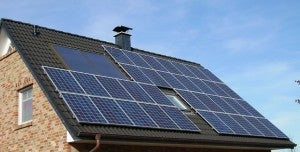2 Ways El Paso Just Upped Texas’ Solar Game
 The city of El Paso has many nicknames, but “The Sun City” is probably the most well-known. After two important energy updates this summer, West Texas’ largest city has even more reason to call itself that.
The city of El Paso has many nicknames, but “The Sun City” is probably the most well-known. After two important energy updates this summer, West Texas’ largest city has even more reason to call itself that.
First, El Paso Electric, the public utility that serves nearly half a million customers, reached a major milestone: It is now officially 100 percent coal-free and has pledged to increase its solar investment. Second, the utility agreed to eliminate its proposal that would have resulted in different electricity prices for customers with solar panels at their homes. Such a pricing structure would have placed an unnecessary burden on El Pasoans with solar.
Sunny El Paso has incredible potential for solar power, and both of these developments are positive signs for the city’s clean energy future. Let’s take a closer look at each.
First coal-free Texas utility
El Paso Electric, which serves both Texas and New Mexico, is now the only utility in either state to produce coal-free electricity. At the end of a 50-year service contract, the utility sold its remaining share of a New Mexico coal power plant, and is planning to meet future demand through increased investment in utility-scale solar.
Less coal means less harmful pollution, or avoiding “more than 2 billion pounds of carbon dioxide from the atmosphere every year, which is the equivalent to taking 190,000 cars off the road and planting 20 million trees,” according to El Paso Electric. Solar panels, on the other hand, release no carbon pollution and will save a lot of water: Coal-generated electricity requires a huge amount of water for cooling and distribution, while solar needs little to none.
The utility’s decision benefits both the environment and the economy. “This decision was not only the best environmental decision for our community, but it was also beneficial financially for all of our customers,” said Mary Kipp, CEO of El Paso Electric.
[Tweet “2 Ways El Paso Just Upped Texas’ Solar Game”]
Avoiding unnecessary solar barriers
In addition to its major coal-free announcement, the utility reached a unanimous settlement in its rate case pending before the Public Utility Commission of Texas. Essentially a utility’s pitch for higher electricity prices for customers, a rate case involves multiple parties – including state and local governments, along with consumer and environmental advocacy groups – trying to determine the rules of the road by which the utility will operate until the next rate case. El Paso Electric was proposing an electricity rate structure that would have raised costs for most existing residential solar customers. Under the proposed structure, people with solar at home – who most likely decided to install panels based on expected savings – would have suddenly been hit with an unanticipated, additional monthly charge.
Moreover, the utility’s original proposal would have made it impossible for people considering installing solar panels to determine what the impact would be to their cost for electricity. That’s because the proposed structure included new demand charges – which are based on the maximum amount of energy a customer uses at any given point over the course of a month – without the information needed to understand and manage them.
Fortunately, after listening to and engaging with numerous environmental and consumer advocates, as well as the area’s legislative leadership and the City’s Mayor and City Council, El Paso Electric agreed to a compromise and abandoned the proposed rate structure. The move will help empower El Pasoans to produce their own clean energy, without unnecessarily increasing electric bills. Hopefully, El Paso Electric will not propose another anti-solar charge for its residential customers when it files its next rate case – expected in the first quarter of 2017.
Amid Texas’ overall momentum toward a smarter electric grid, El Paso Electric is proving itself to be a leader in the clean energy economy. We hope it will continue to support and advance resources like solar power, giving El Paso even more claim to the nickname, “The Sun City.”
This post originally appeared on our Texas Clean Air Matters blog.










